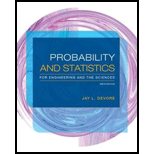
Concept explainers
Consider the following two questions designed to assess quantitative literacy:
a. What is 15% of 1000?
b. A store is offering a 15% off sale on all TVs. The most popular television is normally priced at $1000. How much money would a customer save on the television during this sale? Suppose the first question is asked of 200 randomly selected college students, with 164 answering correctly; the second one is asked of a different random sample of 200 college students, resulting in 140 correct responses (the sample percentages agree with those given in the article “Using the Right Yardstick: Assessing Financial Literacy Measures by Way of Financial Well-Being,” J. of Consumer Affairs, 2013: 243–262; the investigators found that those who answered such questions correctly, particularly questions with context, were significantly more successful in their investment decisions than those who did not answer correctly). Carry out a test of hypotheses at significance level .05 to decide if the true proportion of correct responses to the question without context exceeds that for the one with context.
Trending nowThis is a popular solution!

Chapter 9 Solutions
Probability and Statistics for Engineering and the Sciences
 Glencoe Algebra 1, Student Edition, 9780079039897...AlgebraISBN:9780079039897Author:CarterPublisher:McGraw Hill
Glencoe Algebra 1, Student Edition, 9780079039897...AlgebraISBN:9780079039897Author:CarterPublisher:McGraw Hill Big Ideas Math A Bridge To Success Algebra 1: Stu...AlgebraISBN:9781680331141Author:HOUGHTON MIFFLIN HARCOURTPublisher:Houghton Mifflin Harcourt
Big Ideas Math A Bridge To Success Algebra 1: Stu...AlgebraISBN:9781680331141Author:HOUGHTON MIFFLIN HARCOURTPublisher:Houghton Mifflin Harcourt

